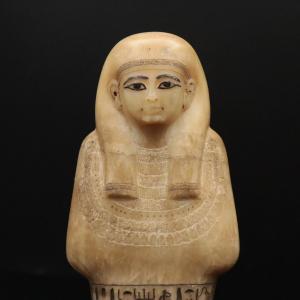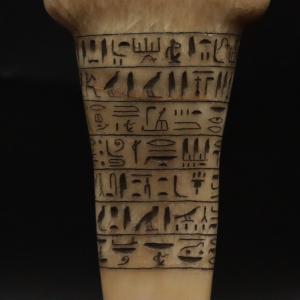
A one of a kind object, a shabti from the tomb of Tutankhamun’s Great-Grandfather, is being shown for the first time at the Barakat Gallery in London
— Shabti of Yuya
LONDON, UNITED KINGDOM, November 1, 2023 /EINPresswire.com/ — In the shifting sands of Egypt’s Western Desert, in the shadow of a great pyramidal mountain, is the Valley of the Kings. When the Pharaohs realised that the pyramids had been easy prey for tomb robbers, it was decided that they would instead be buried in great subterranean tombs, extending hundreds of metres into the ground, in the unforgiving cliffs of the Valley. These tombs are no less impressive than the pyramids, in the manpower it took to build them, and in the sumptuous decoration of their interiors. But tomb robbers found a way. Through bribery, extortion, coercion, and inside men among the tomb builders, one by one the Pharaohs’ tombs were again robbed of their splendour. All, that is, except the tomb of Tutankhamun.
The discovery of Tutankhamun’s tomb in 1922 propelled this little-known and relatively insignificant boy-king, and his discoverer Howard Carter, to international fame. His gold mask is perhaps the best-known ancient artefact in the world, adorning everything from banknotes to fridge magnets in his home country. But his was not the first intact tomb discovered in the Valley. In 1907, a team including Howard Carter made what was, at the time, the greatest archaeological find in history: the intact tomb of Yuya and Tuya.
Yuya, and his wife Tuya, were not born royal. Yuya, in fact, might have been the son of Syrian immigrants. He grew up in a backwater town called Akhmim, in a family of no great note. But through his own shameless self-promotion, he worked his way up to some of the highest offices in the land. Eventually, his daughter Tiye was married off to the Pharaoh himself, Amenhotep III, and became his Great Royal Wife. Their long and successful marriage produced a son, the legendary heretic-king Akhenaten, whose own son was Tutankhamun.
The remarkable figure now on show at the Barakat Gallery in London is a shabti from Yuya’s tomb. Today valued at £3 million, the statue was purchased on the London market in the 1920s. Shabti were magical figures. For the Egyptians, the afterlife was a luscious river valley, the Field of Reeds, and everybody got a plot of land. But as in life, the land must be worked to produce a harvest. While the poor would spend the rest of eternity toiling in their own fields, the rich had little magical statues, imbued with a spell from the Book of the Dead. These statues were believed to come to life in the afterlife, upon the command of their owners, to do all the dirty work.
Yuya’s shabti is a remarkable work of art, befitting a grandfather and great-grandfather of Pharaohs. Standing at 33 centimetres, it is made of alabaster, a stone considered sacred by the Ancient Egyptians thanks to its remarkable translucent quality. The shabti is created in Yuya’s own image, that of a handsome man with a round face and piercing eyes, picked out in black pigment. Across the front is an inscription, a spell to activate the shabti. “If you are called upon in respect to me,” it proclaims, “you shall say ‘Me! Here I am!’.”
This unique object, the only of its kind in private hands, is available to view at the Barakat Gallery, 31 Brook Street, London.
About the Barakat Gallery
The Barakat Gallery is the world’s largest for-sale collection of ancient art, spanning cultures on all continents, and from the Prehistoric to the Twentieth Century AD. With galleries in London, Los Angeles, Hong Kong, Seoul, Marrakech and Amman, Barakat brings ancient art within reach of a global community of collectors and enthusiasts. Founded in Jerusalem nearly 150 years ago, the Barakat Collection is now under the custodianship of Fayez Barakat, perhaps the world’s most notable antiquities dealer, and a well-respected contemporary artist in his own right.
www.barakatgallery.eu
www.barakat.kr
https://fayezbarakat.art
###
Christopher Cooper
Barakat London
+442074937778 ext.
email us here
![]()
Originally published at https://www.einpresswire.com/article/665596954/tomb-figure-of-king-tut-s-great-grandfather-on-display-at-barakat-london






